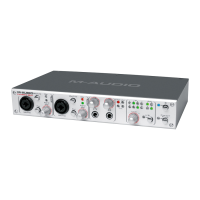Open your audio software and the FireWire 1814 Control Panel.
1. In the FireWire 1814 Control Panel, click the mixer tab. (Let’s assume that we’re
recording with the analog Line Inputs 1 and 2, and that we’re monitoring from the
line outputs 1/2 in stereo.) Assign the analog in 1/2 channel output routing to bus
1/2, and bring up the channel’s faders until you begin to hear the source that is
connected to the line inputs. See the previous section, “Adjusting the Input Levels,”
for more information.
2. In your audio software, enable tracks to record from the FireWire 1814’s analog Line
Inputs 1/2. If necessary, mute those channels so that you don’t hear the tracks from
the program while recording. (Remember, we’re direct monitoring the inputs of the
FireWire 1814.)
3. If you have tracks already recorded in your audio software that you wish to overdub
along to, play those tracks and get a monitor balance between the tracks you are
recording and the tracks already recorded by adjusting the analog in faders in the
FireWire 1814 Control Panel’s mixer page. Check the Control Panel’s output page
to make sure that the combined input and sw rtn levels are not too hot (reaching
into the red) for the assigned output. If they are, try lowering both until the output
level ceases to reach the red.
If you find that you need to fine-tune this monitor balance by going back and forth
between your audio software and the FireWire 1814 Control Panel, you might want to
assign the level controller to control the analog in faders in the FireWire 1814 Control
Panel, at least while you’re setting up for recording. For more information, see the
section, “Using the level controller assignments.”
As mentioned, while the advantages to this type of monitoring are obvious (very low
latency), the inability to add effects can be seen as a drawback. That’s why we created
the aux sends in the FireWire 1814 Control Panel’s mixer. These aux sends will allow
you to add external effects while direct monitoring. See the section, “Adding Effects
While Direct Monitoring,” for more information.
General Recording Instructions
The FireWire 1814’s analog and digital inputs will appear as inputs in your audio software.
Depending on your application of choice, these may be labeled as ASIO, WDM, or
CoreAudio inputs, and may be shown as either mono or stereo inputs. For example, in an
ASIO-based application (e.g., Cubase, Nuendo, Logic) the FireWire 1814’s inputs will
appear as:
FireWire 1814 Analog Input 1 – to – FireWire 1814 Analog Input 8
FireWire 1814 ADAT Input 1 – to – FireWire 1814 ADAT Input 8
FireWire 1814 S/PDIF Input L (when spdif is enabled)
FireWire 1814 S/PDIF Input R (when spdif is enabled)
All of the above driver devices correspond to their respective hardware inputs on the
FireWire 1814, and their naming is designed to reflect that. Choose an available track in
your audio software and route the input signal to it. To do this, select the input source
for the track and enable it for recording. Refer to your audio software’s documentation
for further information. If you’re using the optical S/PDIF input, remember to choose the

